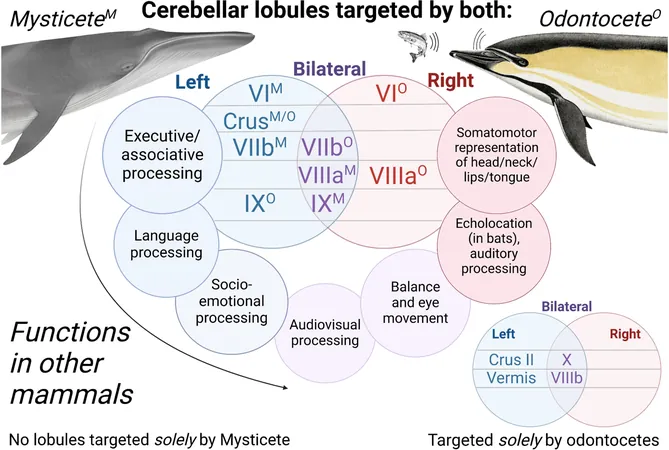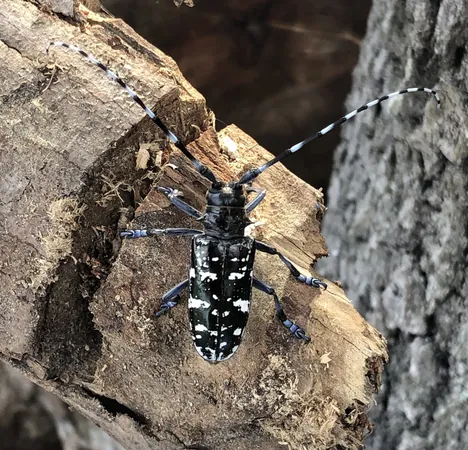
Unlocking the Secrets of Echolocation: How Dolphins and Whales Use Sound to Navigate
2025-06-09
Author: Noah
Wonders of Sound: The Echolocation Superpower
Toothed whales, including dolphins and certain species of whales, possess an extraordinary ability—echolocation. This remarkable skill allows them to navigate murky waters, detect objects, and even hunt for fish by emitting clicking sounds. When these clicks bounce back after hitting objects, they create what scientists call the "echoic return signal." This intricate form of biosonar is an evolutionary marvel that few animals possess.
Groundbreaking Research on Dolphin Brains
Recent research spearheaded by scientists from prestigious institutions such as the Woods Hole Oceanographic Institution and Oxford University is shedding new light on how the brains of dolphins have adapted to support echolocation. By dissecting the brains of stranded cetaceans, the team compared the auditory pathways of echolocating dolphins with those of non-echolocating baleen whales, particularly the sei whale.
Evolutionary Insights from Dolphin and Whale Ancestry
Despite sharing a common ancestor, dolphins have developed echolocation while baleen whales have not. This groundbreaking study marks the first comprehensive comparison of brain networks between these two vastly different types of whales, revealing that dolphin echolocation operates more like "touching" with sound rather than visualizing with sight.
Mapping the Brain: A Journey into the Unknown
Lead researcher Sophie Flem emphasized the significance of understanding how auditory pathways differ between echolocating and non-echolocating species. Traditional brain mapping techniques have not been fully applicable to dolphins. However, researchers cleverly navigated this challenge by focusing on the inferior colliculus—a key midbrain structure central to auditory processing. This approach illuminated the intricate pathways that help dolphins process sound.
Surprising Findings: Echolocation and Brain Connectivity
Contrary to expectations, the study discovered that dolphins, while possessing more projection sites in their cortex, did not have stronger cortical connections compared to the sei whale. The real difference lay in the descending pathways from the inferior colliculi to the cerebellum, providing tantalizing clues about how dolphins utilize echolocation to interact with their environment.
Echolocating: More Than Just Hearing
Dolphins don’t just hear sounds; they produce them, creating a feedback loop that’s essential for echolocation. Peter Tyack, a co-author of the study, likened it to groping for a light switch in the dark—dolphins must actively direct their clicks to navigate and understand their surroundings. This dual role of sound as both a tool for communication and navigation makes echolocation a unique sensory experience.
Technical Innovations Revolutionizing Brain Research
Imaging dolphin brains for this research posed considerable challenges, especially given the size difference between a sei whale brain and a human brain. However, with advances in diffusion imaging techniques pioneered by experts like Karla Miller of Oxford and Ben Inglis of UC Berkeley, scientists were able to obtain clearer, high-quality images, opening doors to new discoveries.
What’s Next for Dolphin Research?
The researchers are not stopping here. With plans to explore more cetacean brains, including new baleen whale specimens, they aim to investigate vocal control pathways unique to dolphins. Senior author Peter Cook noted that these studies will unravel the complexities of dolphin vocal behavior, which is unlike anything seen in the animal kingdom.
Conclusion: A New Dawn for Whale and Dolphin Research
As we unlock the mysteries of how these incredible marine mammals navigate and communicate, we're not only deepening our understanding of their evolutionary journey but also gaining insights that could reshape our perceptions of intelligence in the animal world. With each fascinating discovery, dolphins and whales continue to teach us about the wonders of nature.









 Brasil (PT)
Brasil (PT)
 Canada (EN)
Canada (EN)
 Chile (ES)
Chile (ES)
 Česko (CS)
Česko (CS)
 대한민국 (KO)
대한민국 (KO)
 España (ES)
España (ES)
 France (FR)
France (FR)
 Hong Kong (EN)
Hong Kong (EN)
 Italia (IT)
Italia (IT)
 日本 (JA)
日本 (JA)
 Magyarország (HU)
Magyarország (HU)
 Norge (NO)
Norge (NO)
 Polska (PL)
Polska (PL)
 Schweiz (DE)
Schweiz (DE)
 Singapore (EN)
Singapore (EN)
 Sverige (SV)
Sverige (SV)
 Suomi (FI)
Suomi (FI)
 Türkiye (TR)
Türkiye (TR)
 الإمارات العربية المتحدة (AR)
الإمارات العربية المتحدة (AR)